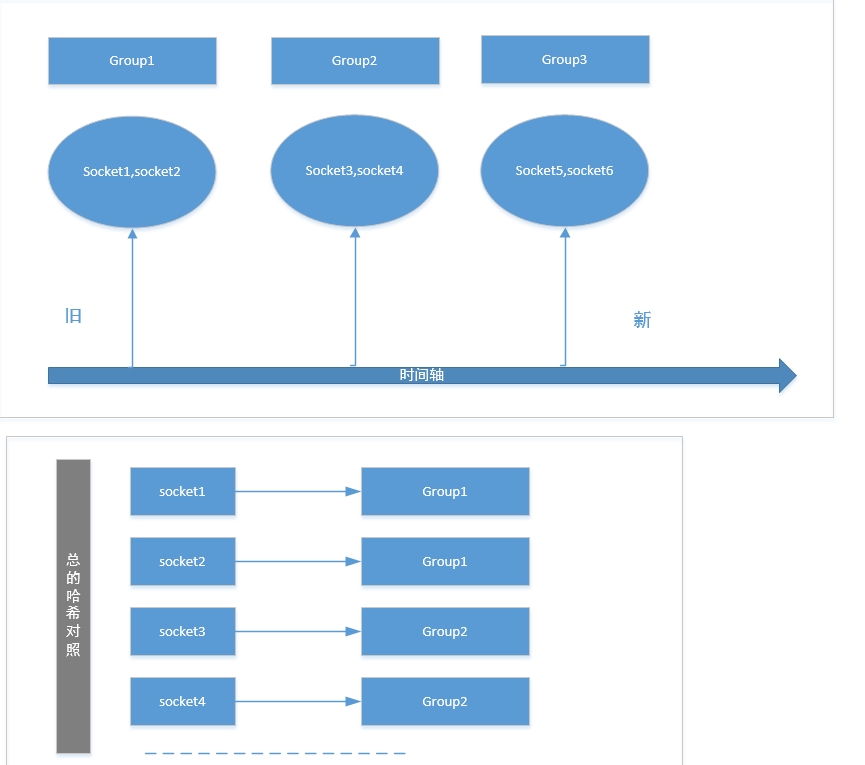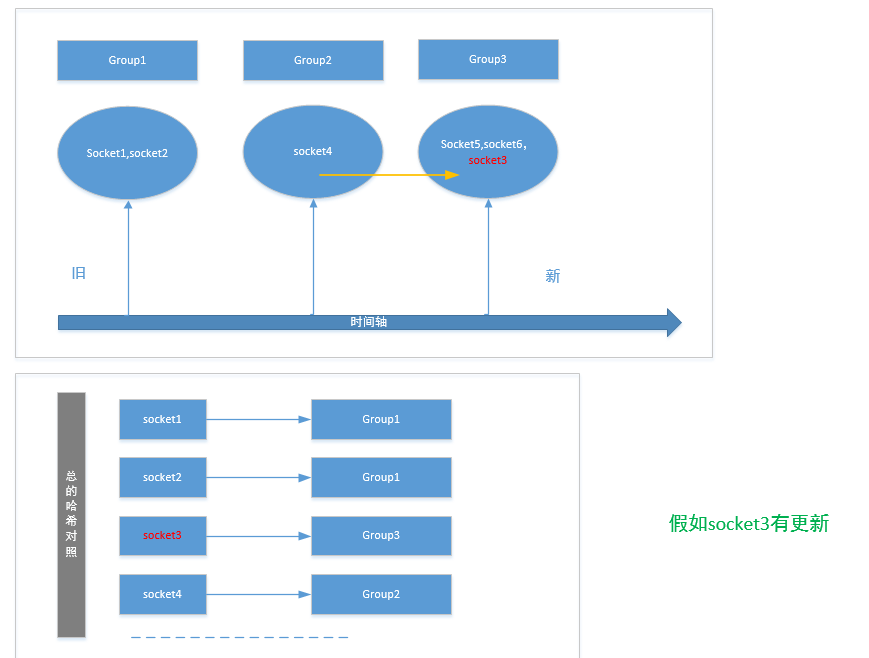这篇文章主要介绍了c# socket心跳超时检测的思路(适用于超大量TCP连接情况下),帮助大家更好的理解和学习使用c#,感兴趣的朋友可以了解下
假设一种情景:
TCP服务器有1万个客户端连接,如果客户端5秒钟不发数据,则要断开。服务端如何检测客户端是否超时?这看起来是一个非常简单的问题,其实不然!
最简单的处理方法是:
启动一个线程,每隔一段时间,检查每个连接是否超时。每次处理需要1万次检查。计算量太大!检查的时间间隔不能太小,否则大大增加计算量;如果间隔时间太大,超时误差会增大。
本文提出一种新颖的处理方法,就是针对这个看似简单而不易解决的问题!(以下用socket表示一个客户端连接)
1 内存布局图

假设socket3有新的数据到达,需要更新socket3所在的时间轴,处理逻辑如下:

2 处理过程分析:
基本的处理思路就是增加时间轴概念。将socket按最后更新时间排序。因为时间是连续的,不可能将时间分割太细。首先将时间离散,比如属于同一秒内的更新,被认为是属于同一个时间点。离散的时间间隔称为时间刻度,该刻度值可以根据具体情况调整。刻度值越小,超时计算越精确;但是计算量增大。如果时间刻度为10毫秒,则一秒的时间长度被划分为100份。所以需要对更新时间做规整,代码如下:
DateTime CreateNow()
{
DateTime now = DateTime.Now;
int m = 0;
if(now.Millisecond != 0)
{
if(_minimumScaleOfMillisecond == 1000)
{
now = now.AddSeconds(1); //尾数加1,确保超时值大于 给定的值
}
else
{
//如果now.Millisecond为16毫秒,精确度为10毫秒。则转换后为20毫秒
m = now.Millisecond - now.Millisecond % _minimumScaleOfMillisecond + _minimumScaleOfMillisecond;
if(m>=1000)
{
m -= 1000;
now = now.AddSeconds(1);
}
}
}
return new DateTime(now.Year, now.Month, now.Day, now.Hour, now.Minute, now.Second,m);
}属于同一个时间刻度的socket,被放入在一个哈希表中(见图中Group)。存放socket的类如下:
class SameTimeKeyGroup<T>
{
DateTime _timeStamp;
public DateTime TimeStamp => _timeStamp;
public SameTimeKeyGroup(DateTime time)
{
_timeStamp = time;
}
public HashSet<T> KeyGroup { get; set; } = new HashSet<T>();
public bool ContainKey(T key)
{
return KeyGroup.Contains(key);
}
internal void AddKey(T key)
{
KeyGroup.Add(key);
}
internal bool RemoveKey(T key)
{
return KeyGroup.Remove(key);
}
}定义一个List表示时间轴:
List<SameTimeKeyGroup<T>> _listTimeScale = new List<SameTimeKeyGroup<T>>();在_listTimeScale 前端的时间较旧,所以链表前端就是有可能超时的socket。
当有socket需要更新时,需要快速知道socket所在的group。这样才能将socket从旧的group移走,再添加到新的group中。需要新增一个链表:
Dictionary<T, SameTimeKeyGroup<T>> _socketToSameTimeKeyGroup = new Dictionary<T, SameTimeKeyGroup<T>>();2.1 当socket有新的数据到达时,处理步骤:
- 查找socket的上一个群组。如果该群组对应的时刻和当前时刻相同(时间都已经离散,才有可能相同),无需更新时间轴。
- 从旧的群组删除,增加到新的群组。
public void UpdateTime(T key)
{
DateTime now = CreateNow();
//是否已存在,从上一个时间群组删除
if (_socketToSameTimeKeyGroup.ContainsKey(key))
{
SameTimeKeyGroup<T> group = _socketToSameTimeKeyGroup[key];
if (group.ContainKey(key))
{
if (group.TimeStamp == now) //同一时间更新,无需移动
{
return;
}
else
{
group.RemoveKey(key);
_socketToSameTimeKeyGroup.Remove(key);
}
}
}
//从超时组 删除
_timeoutSocketGroup.Remove(key);
//加入到新组
SameTimeKeyGroup<T> groupFromScaleList = GetOrCreateSocketGroup(now, out bool newCreate);
groupFromScaleList.AddKey(key);
_socketToSameTimeKeyGroup.Add(key, groupFromScaleList);
if (newCreate)
{
AdjustTimeout();
}
}2.2 获取超时的socket
时间轴从旧到新,对比群组的时间与超时时刻。就是链表_listTimeScale,从0开始查找。
/// <summary>
///timeLimit 值为超时时刻限制
///比如DateTime.Now.AddMilliseconds(-1000);表示 返回一秒钟以前的数据
/// </summary>
/// <param name="timeLimit">该时间以前的socket会被返回</param>
/// <returns></returns>
public List<T> GetTimeoutValue(DateTime timeLimit, bool remove = true)
{
if((DateTime.Now - timeLimit) > _maxSpan )
{
Debug.Write("GetTimeoutSocket timeLimit 参数有误!");
}
//从超时组 读取
List<T> result = new List<T>();
foreach(T key in _timeoutSocketGroup)
{
_timeoutSocketGroup.Add(key);
}
if(remove)
{
_timeoutSocketGroup.Clear();
}
while (_listTimeScale.Count > 0)
{
//时间轴从旧到新,查找对比
SameTimeKeyGroup<T> group = _listTimeScale[0];
if(timeLimit >= group.TimeStamp)
{
foreach (T key in group.KeyGroup)
{
result.Add(key);
if (remove)
{
_socketToSameTimeKeyGroup.Remove(key);
}
}
if(remove)
{
_listTimeScale.RemoveAt(0);
}
}
else
{
break;
}
}
return result;
}3 使用举例
//创建变量。最大超时时间为600秒,时间刻度为1秒
TimeSpanManage<Socket> _deviceActiveManage = TimeSpanManage<Socket>.Create(TimeSpan.FromSeconds(600), 1000);
//当有数据到达时,调用更新函数
_deviceActiveManage.UpdateTime(socket);
//需要在线程或定时器中,每隔一段时间调用,找出超时的socket
//找出超时时间超过600秒的socket。
foreach (Socket socket in _deviceActiveManage.GetTimeoutValue(DateTime.Now.AddSeconds(-600)))
{
socket.Close();
}4 完整代码
/// <summary>
/// 超时时间 时间间隔处理
/// </summary>
class TimeSpanManage<T>
{
TimeSpan _maxSpan;
int _minimumScaleOfMillisecond;
int _scaleCount;
List<SameTimeKeyGroup<T>> _listTimeScale = new List<SameTimeKeyGroup<T>>();
private TimeSpanManage()
{
}
/// <summary>
///
/// </summary>
/// <param name="maxSpan">最大时间时间</param>
/// <param name="minimumScaleOfMillisecond">最小刻度(毫秒)</param>
/// <returns></returns>
public static TimeSpanManage<T> Create(TimeSpan maxSpan, int minimumScaleOfMillisecond)
{
if (minimumScaleOfMillisecond <= 0)
throw new Exception("minimumScaleOfMillisecond 小于0");
if (minimumScaleOfMillisecond > 1000)
throw new Exception("minimumScaleOfMillisecond 不能大于1000");
if (maxSpan.TotalMilliseconds <= 0)
throw new Exception("maxSpan.TotalMilliseconds 小于0");
TimeSpanManage<T> result = new TimeSpanManage<T>();
result._maxSpan = maxSpan;
result._minimumScaleOfMillisecond = minimumScaleOfMillisecond;
result._scaleCount = (int)(maxSpan.TotalMilliseconds / minimumScaleOfMillisecond);
result._scaleCount++;
return result;
}
Dictionary<T, SameTimeKeyGroup<T>> _socketToSameTimeKeyGroup = new Dictionary<T, SameTimeKeyGroup<T>>();
public void UpdateTime(T key)
{
DateTime now = CreateNow();
//是否已存在,从上一个时间群组删除
if (_socketToSameTimeKeyGroup.ContainsKey(key))
{
SameTimeKeyGroup<T> group = _socketToSameTimeKeyGroup[key];
if (group.ContainKey(key))
{
if (group.TimeStamp == now) //同一时间更新,无需移动
{
return;
}
else
{
group.RemoveKey(key);
_socketToSameTimeKeyGroup.Remove(key);
}
}
}
//从超时组 删除
_timeoutSocketGroup.Remove(key);
//加入到新组
SameTimeKeyGroup<T> groupFromScaleList = GetOrCreateSocketGroup(now, out bool newCreate);
groupFromScaleList.AddKey(key);
_socketToSameTimeKeyGroup.Add(key, groupFromScaleList);
if (newCreate)
{
AdjustTimeout();
}
}
public bool RemoveSocket(T key)
{
bool result = false;
if (_socketToSameTimeKeyGroup.ContainsKey(key))
{
SameTimeKeyGroup<T> group = _socketToSameTimeKeyGroup[key];
result = group.RemoveKey(key);
_socketToSameTimeKeyGroup.Remove(key);
}
//从超时组 删除
bool result2 = _timeoutSocketGroup.Remove(key);
return result || result2;
}
/// <summary>
///timeLimit 值为超时时刻限制
///比如DateTime.Now.AddMilliseconds(-1000);表示 返回一秒钟以前的数据
/// </summary>
/// <param name="timeLimit">该时间以前的socket会被返回</param>
/// <returns></returns>
public List<T> GetTimeoutValue(DateTime timeLimit, bool remove = true)
{
if((DateTime.Now - timeLimit) > _maxSpan )
{
Debug.Write("GetTimeoutSocket timeLimit 参数有误!");
}
//从超时组 读取
List<T> result = new List<T>();
foreach(T key in _timeoutSocketGroup)
{
_timeoutSocketGroup.Add(key);
}
if(remove)
{
_timeoutSocketGroup.Clear();
}
while (_listTimeScale.Count > 0)
{
//时间轴从旧到新,查找对比
SameTimeKeyGroup<T> group = _listTimeScale[0];
if(timeLimit >= group.TimeStamp)
{
foreach (T key in group.KeyGroup)
{
result.Add(key);
if (remove)
{
_socketToSameTimeKeyGroup.Remove(key);
}
}
if(remove)
{
_listTimeScale.RemoveAt(0);
}
}
else
{
break;
}
}
return result;
}
HashSet<T> _timeoutSocketGroup = new HashSet<T>();
private void AdjustTimeout()
{
while (_listTimeScale.Count > _scaleCount)
{
SameTimeKeyGroup<T> group = _listTimeScale[0];
foreach (T key in group.KeyGroup)
{
_timeoutSocketGroup.Add(key);
}
_listTimeScale.RemoveAt(0);
}
}
private SameTimeKeyGroup<T> GetOrCreateSocketGroup(DateTime now, out bool newCreate)
{
if (_listTimeScale.Count == 0)
{
newCreate = true;
SameTimeKeyGroup<T> result = new SameTimeKeyGroup<T>(now);
_listTimeScale.Add(result);
return result;
}
else
{
SameTimeKeyGroup<T> lastGroup = _listTimeScale[_listTimeScale.Count - 1];
if (lastGroup.TimeStamp == now)
{
newCreate = false;
return lastGroup;
}
newCreate = true;
SameTimeKeyGroup<T> result = new SameTimeKeyGroup<T>(now);
_listTimeScale.Add(result);
return result;
}
}
DateTime CreateNow()
{
DateTime now = DateTime.Now;
int m = 0;
if(now.Millisecond != 0)
{
if(_minimumScaleOfMillisecond == 1000)
{
now = now.AddSeconds(1); //尾数加1,确保超时值大于 给定的值
}
else
{
//如果now.Millisecond为16毫秒,精确度为10毫秒。则转换后为20毫秒
m = now.Millisecond - now.Millisecond % _minimumScaleOfMillisecond + _minimumScaleOfMillisecond;
if(m>=1000)
{
m -= 1000;
now = now.AddSeconds(1);
}
}
}
return new DateTime(now.Year, now.Month, now.Day, now.Hour, now.Minute, now.Second,m);
}
}
class SameTimeKeyGroup<T>
{
DateTime _timeStamp;
public DateTime TimeStamp => _timeStamp;
public SameTimeKeyGroup(DateTime time)
{
_timeStamp = time;
}
public HashSet<T> KeyGroup { get; set; } = new HashSet<T>();
public bool ContainKey(T key)
{
return KeyGroup.Contains(key);
}
internal void AddKey(T key)
{
KeyGroup.Add(key);
}
internal bool RemoveKey(T key)
{
return KeyGroup.Remove(key);
}
}以上就是c# socket心跳超时检测的思路(适用于超大量TCP连接情况下)的详细内容,更多关于c# socket心跳超时检测的资料请关注得得之家其它相关文章!
本文标题为:c# socket心跳超时检测的思路(适用于超大量TCP连接情况下)


基础教程推荐
- 全局 ASAX - 获取服务器名称 2022-01-01
- 是否可以在 asp classic 和 asp.net 之间共享会话状态 2022-01-01
- 在 VS2010 中的 Post Build 事件中将 bin 文件复制到物 2022-01-01
- 错误“此流不支持搜索操作"在 C# 中 2022-01-01
- 首先创建代码,多对多,关联表中的附加字段 2022-01-01
- 从 VS 2017 .NET Core 项目的发布目录中排除文件 2022-01-01
- JSON.NET 中基于属性的类型解析 2022-01-01
- 如何动态获取文本框中datagridview列的总和 2022-01-01
- 经典 Asp 中的 ResolveUrl/Url.Content 等效项 2022-01-01
- 将事件 TextChanged 分配给表单中的所有文本框 2022-01-01

















